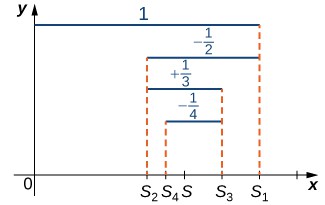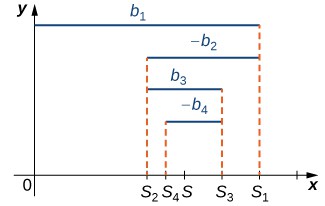Learning Outcomes
- Use the alternating series test to test an alternating series for convergence
- Estimate the sum of an alternating series
A series whose terms alternate between positive and negative values is an alternating series. For example, the series
and
are both alternating series.
Definition
Any series whose terms alternate between positive and negative values is called an alternating series. An alternating series can be written in the form
or
Where [latex]{b}_{n}\ge 0[/latex] for all positive integers n.
Series (1), shown as the first alternating series example, is a geometric series. Since [latex]|r|=|\text{-}\frac{1}{2}|<1[/latex], the series converges. Series (2), shown as the second alternating series example, is called the alternating harmonic series. We will show that whereas the harmonic series diverges, the alternating harmonic series converges.
To prove this, we look at the sequence of partial sums [latex]\left\{{S}_{k}\right\}[/latex] (Figure 1).
Proof
Consider the odd terms [latex]{S}_{2k+1}[/latex] for [latex]k\ge 0[/latex]. Since [latex]\frac{1}{\left(2k+1\right)}<\frac{1}{2k}[/latex],
Therefore, [latex]\left\{{S}_{2k+1}\right\}[/latex] is a decreasing sequence. Also,
Therefore, [latex]\left\{{S}_{2k+1}\right\}[/latex] is bounded below. Since [latex]\left\{{S}_{2k+1}\right\}[/latex] is a decreasing sequence that is bounded below, by the Monotone Convergence Theorem, [latex]\left\{{S}_{2k+1}\right\}[/latex] converges. Similarly, the even terms [latex]\left\{{S}_{2k}\right\}[/latex] form an increasing sequence that is bounded above because
and
Therefore, by the Monotone Convergence Theorem, the sequence [latex]\left\{{S}_{2k}\right\}[/latex] also converges. Since
we know that
Letting [latex]S=\underset{k\to \infty }{\text{lim}}{S}_{2k+1}[/latex] and using the fact that [latex]\frac{1}{\left(2k+1\right)}\to 0[/latex], we conclude that [latex]\underset{k\to \infty }{\text{lim}}{S}_{2k}=S[/latex]. Since the odd terms and the even terms in the sequence of partial sums converge to the same limit [latex]S[/latex], it can be shown that the sequence of partial sums converges to [latex]S[/latex], and therefore the alternating harmonic series converges to [latex]S[/latex].
It can also be shown that [latex]S=\text{ln}2[/latex], and we can write

Figure 1. For the alternating harmonic series, the odd terms [latex]{S}_{2k+1}[/latex] in the sequence of partial sums are decreasing and bounded below. The even terms [latex]{S}_{2k}[/latex] are increasing and bounded above.
[latex]_\blacksquare[/latex]
More generally, any alternating series of form (3) or (4) (see the definition) converges as long as [latex]{b}_{1}\ge {b}_{2}\ge {b}_{3}\ge \cdots [/latex] and [latex]{b}_{n}\to 0[/latex] (Figure 2). The proof is similar to the proof for the alternating harmonic series.

Figure 2. For an alternating series [latex]{b}_{1}-{b}_{2}+{b}_{3}-\cdots [/latex] in which [latex]{b}_{1}>{b}_{2}>{b}_{3}>\cdots [/latex], the odd terms [latex]{S}_{2k+1}[/latex] in the sequence of partial sums are decreasing and bounded below. The even terms [latex]{S}_{2k}[/latex] are increasing and bounded above.
theorem: Alternating Series Test
An alternating series of the form
converges if
- [latex]0\le {b}_{n+1}\le {b}_{n}[/latex] for all [latex]n\ge 1[/latex] and
- [latex]\underset{n\to \infty }{\text{lim}}{b}_{n}=0[/latex].
This is known as the alternating series test.
We remark that this theorem is true more generally as long as there exists some integer [latex]N[/latex] such that [latex]0\le {b}_{n+1}\le {b}_{n}[/latex] for all [latex]n\ge N[/latex].
Example: Convergence of Alternating Series
For each of the following alternating series, determine whether the series converges or diverges.
- [latex]\displaystyle\sum _{n=1}^{\infty }\frac{{\left(-1\right)}^{n+1}}{{n}^{2}}[/latex]
- [latex]\displaystyle\sum _{n=1}^{\infty }\frac{{\left(-1\right)}^{n+1}n}{\left(n+1\right)}[/latex]
try it
Determine whether the series [latex]\displaystyle\sum _{n=1}^{\infty }\frac{{\left(-1\right)}^{n+1}n}{{2}^{n}}[/latex] converges or diverges.
Watch the following video to see the worked solution to the above Try IT.
For closed captioning, open the video on its original page by clicking the Youtube logo in the lower right-hand corner of the video display. In YouTube, the video will begin at the same starting point as this clip, but will continue playing until the very end.
You can view the transcript for this segmented clip of “5.5.1” here (opens in new window).
Try It
Remainder of an Alternating Series
It is difficult to explicitly calculate the sum of most alternating series, so typically the sum is approximated by using a partial sum. When doing so, we are interested in the amount of error in our approximation. Consider an alternating series
satisfying the hypotheses of the alternating series test. Let [latex]S[/latex] denote the sum of this series and [latex]\left\{{S}_{k}\right\}[/latex] be the corresponding sequence of partial sums. From Figure 2, we see that for any integer [latex]N\ge 1[/latex], the remainder [latex]{R}_{N}[/latex] satisfies
theorem: Remainders in Alternating Series
Consider an alternating series of the form
that satisfies the hypotheses of the alternating series test. Let [latex]S[/latex] denote the sum of the series and [latex]{S}_{N}[/latex] denote the [latex]N\text{th}[/latex] partial sum. For any integer [latex]N\ge 1[/latex], the remainder [latex]{R}_{N}=S-{S}_{N}[/latex] satisfies
In other words, if the conditions of the alternating series test apply, then the error in approximating the infinite series by the [latex]N\text{th}[/latex] partial sum [latex]{S}_{N}[/latex] is in magnitude at most the size of the next term [latex]{b}_{N+1}[/latex].
Example: Estimating the Remainder of an Alternating Series
Consider the alternating series
Use the remainder estimate to determine a bound on the error [latex]{R}_{10}[/latex] if we approximate the sum of the series by the partial sum [latex]{S}_{10}[/latex].
try it
Find a bound for [latex]{R}_{20}[/latex] when approximating [latex]\displaystyle\sum _{n=1}^{\infty }\frac{{\left(-1\right)}^{n+1}}{n}[/latex] by [latex]{S}_{20}[/latex].
